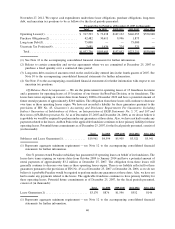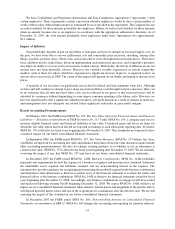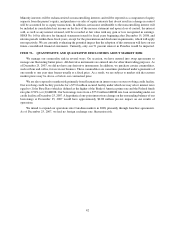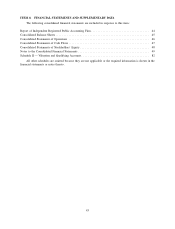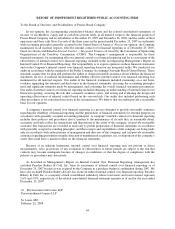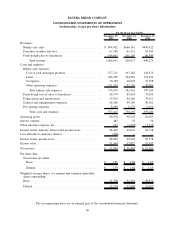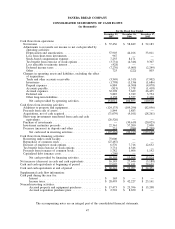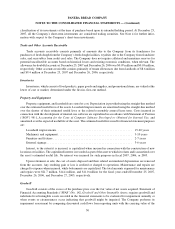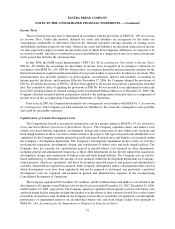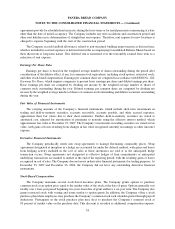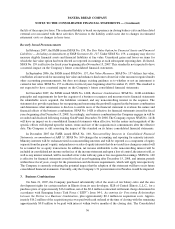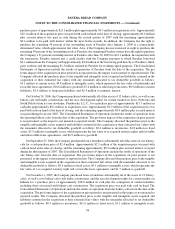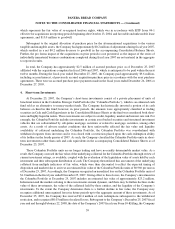Panera Bread 2007 Annual Report Download - page 60
Download and view the complete annual report
Please find page 60 of the 2007 Panera Bread annual report below. You can navigate through the pages in the report by either clicking on the pages listed below, or by using the keyword search tool below to find specific information within the annual report.classification of its investments at the time of purchase based upon its intended holding period. At December 25,
2007, all the Company’s short-term investments are considered trading securities. See Note 4 for further infor-
mation with respect to the Company’s short-term investments.
Trade and Other Accounts Receivable
Trade accounts receivable consists primarily of amounts due to the Company from its franchisees for
purchases of fresh dough from the Company’s fresh dough facilities, royalties due to the Company from franchisee
sales, and receivables from credit card sales. The Company does not require collateral and maintains reserves for
potential uncollectible accounts based on historical losses and existing economic conditions, when relevant. The
allowance for doubtful accounts at December 25, 2007 and December 26, 2006 was $0.07 million and $0.03 million,
respectively. Other accounts receivable consists primarily of tenant allowances due from landlords of $8.6 million
and $9.4 million at December 25, 2007 and December 26, 2006, respectively.
Inventories
Inventories, which consist of food products, paper goods and supplies, and promotional items, are valued at the
lower of cost or market, determined under the first-in, first-out method.
Property and Equipment
Property, equipment, and leaseholds are stated at cost. Depreciation is provided using the straight-line method
over the estimated useful lives of the assets. Leasehold improvements are amortized using the straight-line method
over the shorter of their estimated useful lives or the related reasonably assured lease term. Costs incurred in
connection with the development of internal-use software are capitalized in accordance with Statement of Position
(“SOP”) 98-1, Accounting for the Costs of Computer Software Developed or Obtained for Internal Use, and
amortized over the expected useful life of the asset. The estimated useful lives used for financial statement purposes
are:
Leasehold improvements ............................................... 15-20 years
Machinery and equipment . . . ........................................... 3-10 years
Furniture and fixtures ................................................. 2-7years
External signage ..................................................... 3-6years
Interest, to the extent it is incurred, is capitalized when incurred in connection with the construction of new
locations or facilities. The capitalized interest is recorded as part of the asset to which it relates and is amortized over
the asset’s estimated useful life. No interest was incurred for such purposes in fiscal 2007, 2006, or 2005.
Upon retirement or sale, the cost of assets disposed and their related accumulated depreciation are removed
from the accounts. Any resulting gain or loss is credited or charged to operations. Maintenance and repairs are
charged to expense when incurred, while betterments are capitalized. The total amounts expensed for maintenance
and repairs were $21.7 million, $14.4 million, and $11.0 million for the fiscal years ended December 25, 2007,
December 26, 2006, and December 27, 2005, respectively.
Goodwill
Goodwill consists of the excess of the purchase price over the fair value of net assets acquired. Statement of
Financial Accounting Standards (“SFAS”) No. 142, Goodwill and Other Intangible Assets, requires goodwill and
indefinite-lived intangible assets recorded in the financial statements to be evaluated for impairment annually or
when events or circumstances occur indicating that goodwill might be impaired. The Company performs its
impairment assessment by comparing discounted cash flows from reporting units with the carrying value of the
50
PANERA BREAD COMPANY
NOTES TO THE CONSOLIDATED FINANCIAL STATEMENTS — (Continued)


